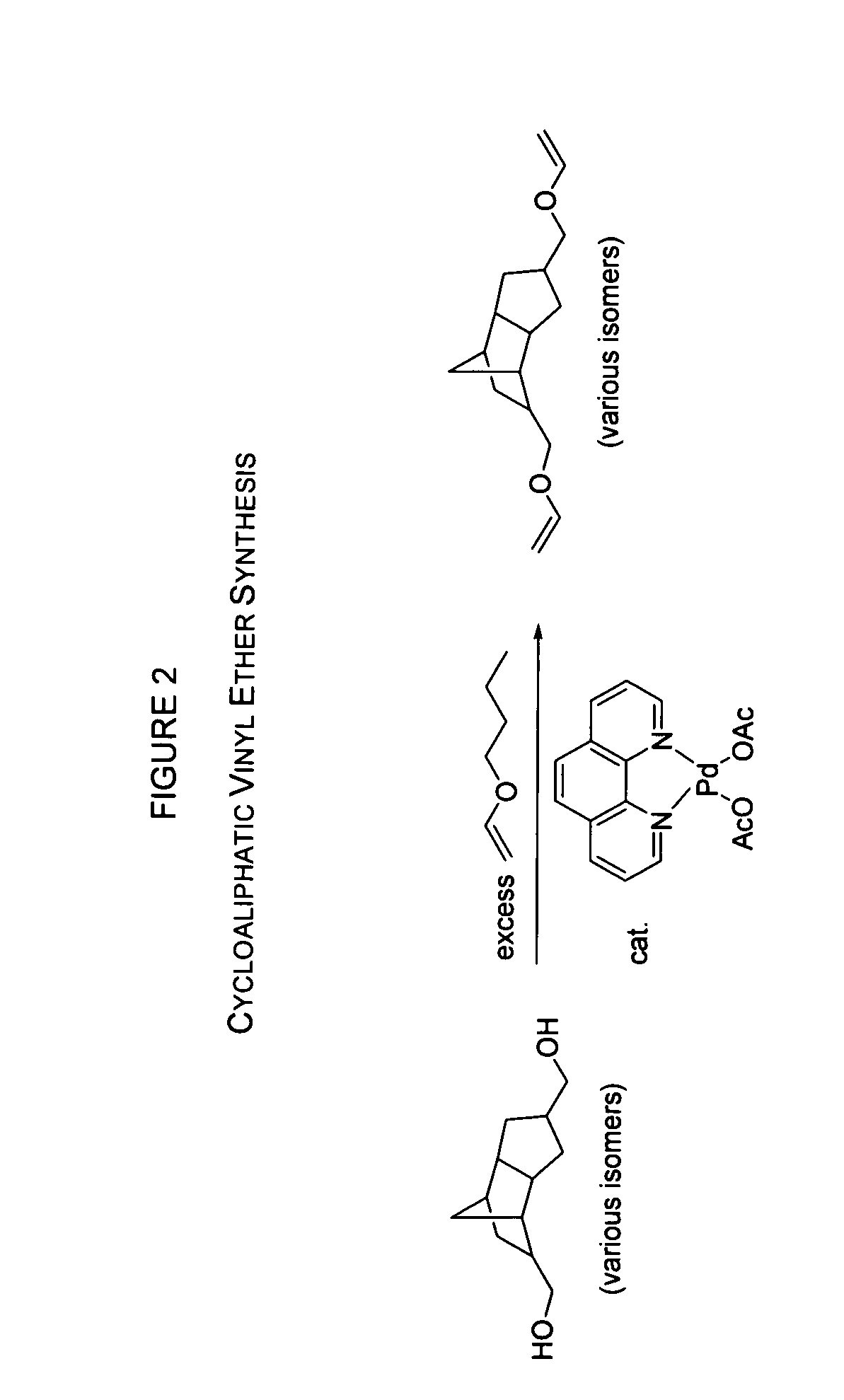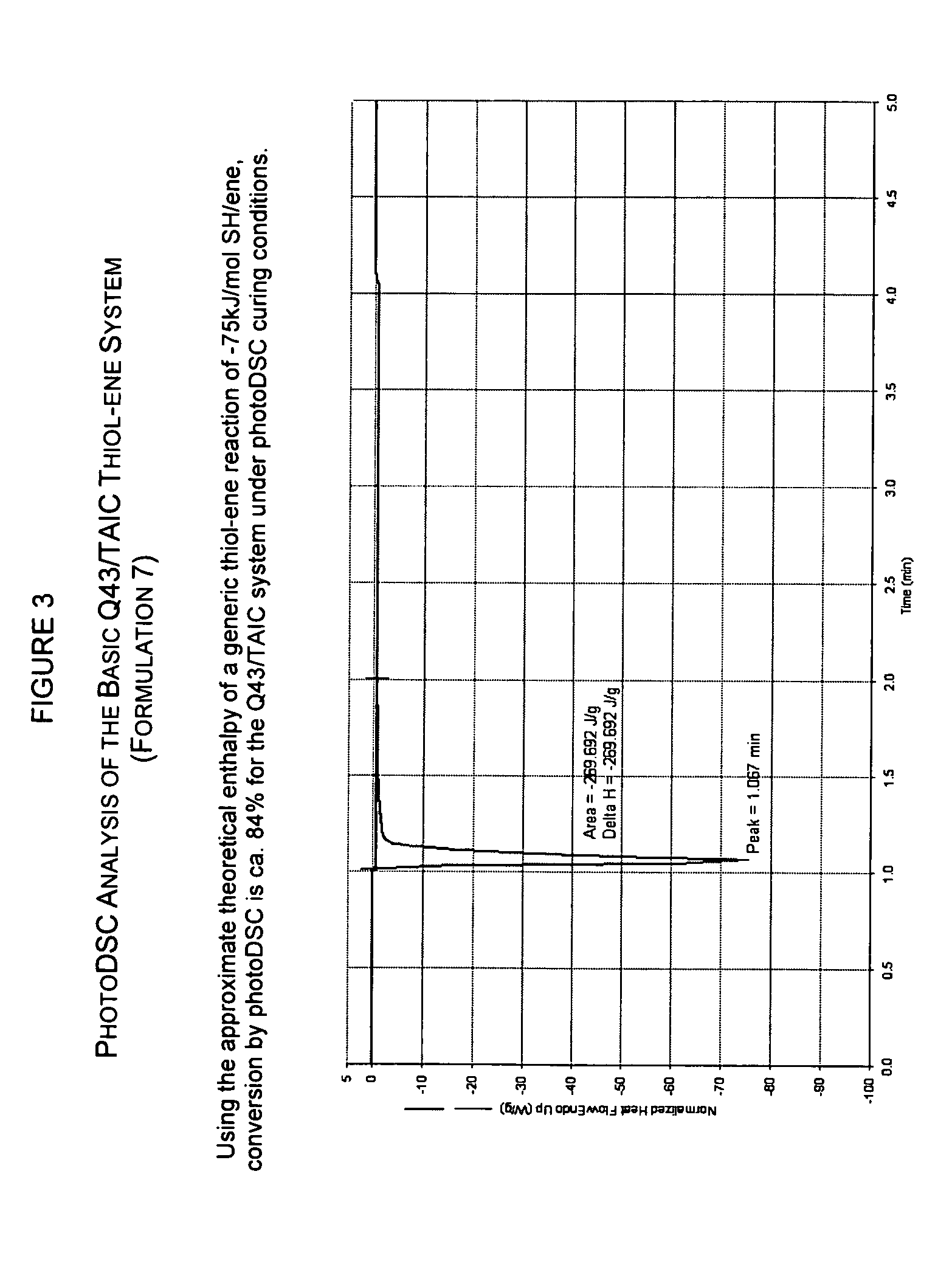Radiation curable cycloaliphatic barrier sealants
a cycloaliphatic and barrier technology, applied in the direction of coatings, basic electric elements, solid-state devices, etc., can solve the problems of many systems that are merely hydrophobic not good barrier materials, and cannot be sufficient to have only a low solubility, and achieve the effect of superior barrier performance and high crosslink density
- Summary
- Abstract
- Description
- Claims
- Application Information
AI Technical Summary
Benefits of technology
Problems solved by technology
Method used
Image
Examples
example 1
UV Curable Cycloaliphatic Acrylic Barriers
[0046] Several UV curable acrylate compositions were formulated by mixing several structurally distinct acrylate resins with a polythiol, a photoinitiator, and fumed silica in parts by weight as shown in Table 1.
TABLE 1UV CURABLE ACRYLATE FORMULATIONSACRYLATEPARTSEQUIVALENTPARTSPARTSFORMULAACRYLATEWEIGHTPARTSPHOTO-FUMEDNUMBERRESIN(G / MOL)POLYTHIOLINITIATORSILICA189.31133.81.95.0HDDA(SR238)289.31483.81.95.0TMPTA(SR351)389.31523.81.95.0DCPDDA(SR833)494.0˜14004.02.00pBD DMA(CN 301)
HDDA is hexanediol diacrylate;
TMPTA is trimethylolpropane tricrylate;
pBD DMA is poly(butadiene)dimethacrylate;
DCPDDA is dicyclopentadienedimethylol diacrylate.
[0047] Q-43 is pentaerythritol tris(3-mercapto-propionate) and is a polythiol, which acts to reduce oxygen inhibition and as a flexibilizer. The Q-43 polythiol has the structure:
[0048] The photoinitiator used was Irgacure 651, obtained from Ciba Specialty Chemicals. The fumed silica acts as a thixotrope ...
example 2
UV Curable Cycloaliphatic Thiol-Ene Barrier Materials
[0054] Several UV curable thiol-ene formulations were prepared according to Table 3 using the same polythiol (Q-43) as in Example 1, various ene components, and a photoinitiator.
TABLE 3UV CURABLE CYCLOALIPHATIC THIOL-ENE BARRIER MATERIALSAND UV CURINGFormula5678910PARTS BY WEIGHT344360605353Q-43 THIOLPARTS BY WEIGHT6541DAC ENEPARTS BY WEIGHT143939TAIC ENEPARTS BY WEIGHT4545TABPA ENEPARTS BY WEIGHT121122PHOTO-INITIATORUV DOSE333333JOULES UVAPER CM2THERMAL BUMP70° C.70° C.70° C.10 min10 min10 minPHOTOPOLYMERIZATION−150−231−117ENTHALPYJ / GTIME TO PEAK4.04.02.4EXOTHERM(SECONDS)
Q-43 is pentaerythritol tetrakis(3-mercpatopropionate);
DAC is diallychlorendate;
TAIC is triallyl is isocyanurate (with 100 ppm BHT stabilizer);
TABPA is tetraallyl bisphenol A.
[0055] The structures of the polyenes are
[0056] The photoinitiator was Irgacure 651, obtained from Ciba Specialty Chemicals and used at a level appropriate for each formulation
[005...
example 3
Epoxy / Vinyl Ether UV Curable Blends
[0062] Several formulations were prepared using the components and parts by weight listed in Table 5 below. The photoinitiator was UV9380C obtained from GE Silicones. The structures of the vinyl ethers are as follows:
[0063] The components were handmixed, followed by mixing in a Speedmixer DAC 150 FV2-K (FlackTek Inc.) for two minutes at 3000 rpm. The resulting pastes were coated onto release-coated PET film using a drawdown bar, and the resulting wet films were UV cured in a Dymax stationary curing unit. UV dose was 3J UVA / cm2, at an intensity of ca. 45 mW UVA / cm2 as measured using an EIT compact radiometer. The cured epoxy / vinyl ether films were removed from the PET backing and analyzed. The equilibrium bulk moisture permeation coefficient of the films was measured using a Mocon Permatran-W 3 / 33 instrument at 50° C. / 100% relative humidity (RH).
TABLE 5BARRIER SEALANTS COMPRISING VINYLETHER / EPOXY BLENDSFORMULAFORMULAFORMULAFORMULA11121314RESIN(...
PUM
| Property | Measurement | Unit |
|---|---|---|
| Molar mass | aaaaa | aaaaa |
| Temperature | aaaaa | aaaaa |
| Temperature | aaaaa | aaaaa |
Abstract
Description
Claims
Application Information
 Login to view more
Login to view more - R&D Engineer
- R&D Manager
- IP Professional
- Industry Leading Data Capabilities
- Powerful AI technology
- Patent DNA Extraction
Browse by: Latest US Patents, China's latest patents, Technical Efficacy Thesaurus, Application Domain, Technology Topic.
© 2024 PatSnap. All rights reserved.Legal|Privacy policy|Modern Slavery Act Transparency Statement|Sitemap



